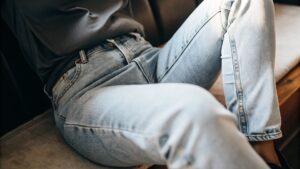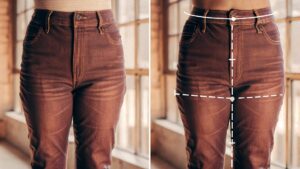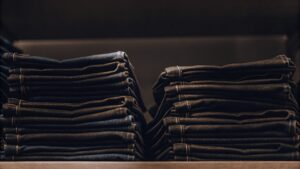Standing in the fitting room with two sizes is confusing. You know jeans change with wear, but picking the wrong size means they will end up in the back of your closet.
It depends entirely on the fabric. For 100% cotton jeans1, a comfortably fitting pair is best. For jeans containing elastane (spandex)2, you should always buy them snug, as they are designed to stretch and mold to your body.

This is one of the most fundamental questions in the world of denim, a question I've answered thousands of times over my 20 years running the DiZNEW factory. It's a puzzle that frustrates shoppers and a technical challenge that denim designers like my friend Dean have to master.
The secret isn't a feeling or a guess; it's written right on the little fabric composition tag3 inside the jeans. Understanding that tag is the key to unlocking the perfect fit every single time. Let's break down the logic so you never have to guess again.
Is it better to buy tighter or looser jeans?
Faced with a choice between too tight and too loose, you're stuck. You fear the tight pair will stay uncomfortable or the loose one will become a baggy mess4 after a few hours.
Always buy jeans with stretch (like spandex or elastane) on the tighter side5. They will relax. For rigid, 100% cotton jeans1, choose the pair that fits comfortably from the start, never one that is painfully tight.
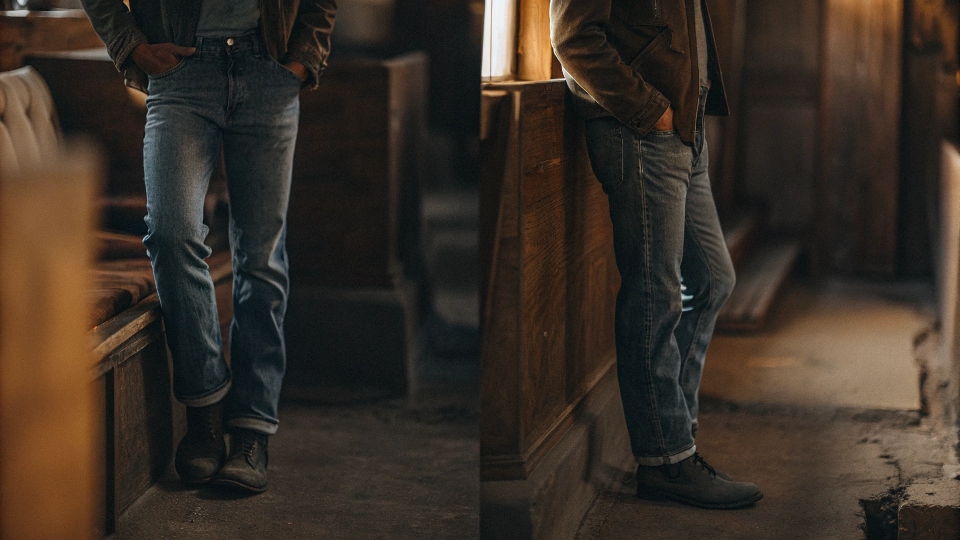
The way a jean behaves is programmed by its fibers. Think of it as two different philosophies of fit. Rigid, 100% cotton denim is an old-school fabric. It's like a good leather belt; it softens and molds to your shape over time, but it doesn't really stretch out in size.
It might give a little in the waist and seat, but it will shrink back when you wash it. If you can't button a pair of 100% cotton jeans in the store, they are too small. That's the end of the story.
On the other hand, stretch denim6 is a modern invention. The addition of elastane (also known as Lycra or spandex) is specifically designed to provide stretch and recovery.When you buy stretch jeans, they should feel very snug—almost like a second skin—but not painfully constricting.
The warmth of your body will relax the fibers, and they will stretch to a perfect, custom fit within the first hour of wear. Buying these loose is the biggest mistake you can make; they will inevitably sag and look baggy by the end of the day.
Is it better to go up or down a size in jeans?
Being stuck between two sizes is frustrating. Sizing up feels sloppy, but sizing down seems impossible. The fabric tag on the jeans holds the simple answer you need.
You should size down if the jeans contain 2% or more elastane (spandex). The fabric is designed for a form-fitting look. You should stick with the comfortable size or go up if the jeans are 100% cotton.

From a manufacturing perspective, we design and cut these two types of jeans very differently. When my designer friend Dean creates a pattern for a stretch jean, he is accounting for the fabric's ability to stretch.
The pattern is intentionally made slightly smaller than the target body measurements. This is called "negative ease." The goal is for the fabric to do its job and hug the body for a sleek silhouette.
If you size up in this style, you are actively working against the garment's intended design.
For a classic, 100% cotton jean, the opposite is true. We cut the pattern "true to size." The fit is meant to respect the fabric's structure, not fight against it.
Trying to size down in rigid denim puts an incredible amount of stress on the seams, the zipper, and the button. It won't look good, and it won't feel good.
The simple rule I tell everyone is this: for rigid denim, you should be able to comfortably slide one flat finger between your body and the waistband. For stretch denim, the waistband should sit flush against your skin with no gap.
When buying denim jeans, should you size up or fit comfortably?
You want a comfortable fit, but experience shows that "comfortable" in the store can mean "baggy" later. This creates doubt about what you should be feeling when you try them on.
"Fit comfortably" is the correct goal for 100% cotton jeans. For stretch jeans, the ideal initial fit is "comfortably snug," not loose. This snugness quickly relaxes into a lasting, comfortable fit that doesn't sag throughout the day.
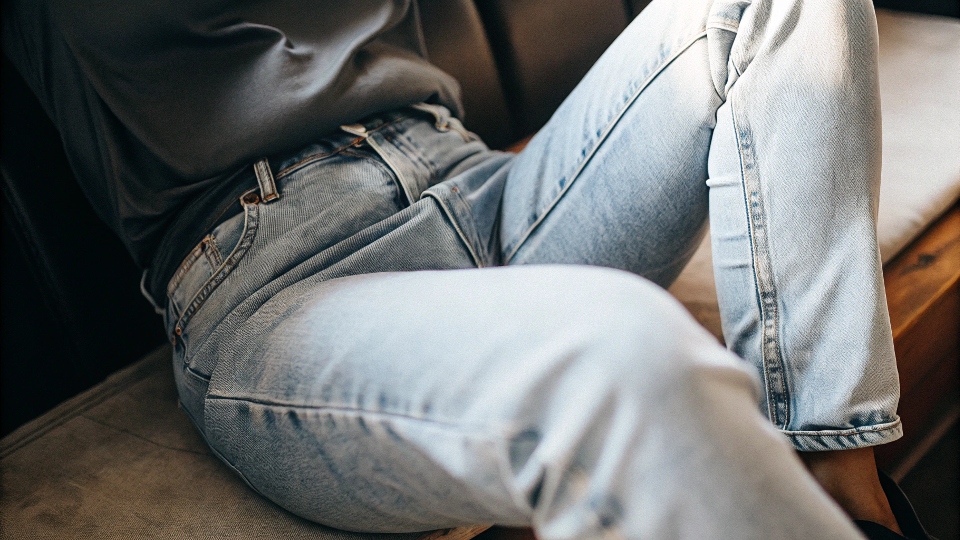
You have to think about the "initial fit" versus the "final fit." At the DiZNEW factory, we are always engineering for the final fit, how the jeans will feel after a day of wear.
For 100% cotton, the initial fit and final fit are very close. The fabric will soften, but it won't expand much.
Therefore, comfort from the moment you put them on is essential. You must be able to sit and bend without the waistband digging into you painfully.
For stretch jeans, the initial fit is just a temporary state. You are buying for the final fit. They should feel tight, especially through the thigh and seat. A good test for stretch denim is the "pinch test."
When you are wearing them, try to pinch the fabric on your thigh. If you can easily pinch an inch or more of loose material, you should size down. If they feel just a little too tight, they are probably the perfect size.
Trust the fabric to do its job. That initial snugness is the key to a pair of jeans that looks great all day long.
Is a size 30 jeans the same as a 10?
Jean sizes are a confusing mix of numbers. Seeing waist sizes like "30" and dress sizes like "10" on different pairs makes choosing the right fit feel like pure guesswork.
As a general guideline, a women's size 30 waist in jeans often corresponds to a US women's dress size 10. However, this is not a universal standard, and sizing varies wildly between brands.
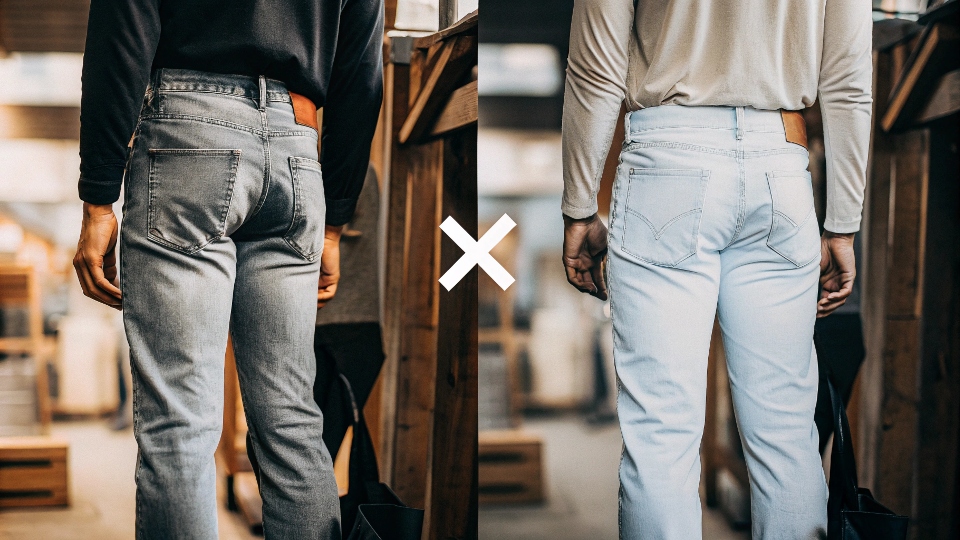
The confusion comes from two different sizing systems used in the apparel industry. The inch-based sizing (e.g., 28, 29, 30, 31) is most common in men's and unisex jeans.
It is supposed to relate directly to the measurement of your waist in inches, making it a more literal system. The dress sizing system (e.g., 8, 10, 12, 14) is more common in women's fashion and is more abstract.
A size "10" doesn't mean "10 inches"; it's just an arbitrary number that a brand assigns to a set of body measurements. This system is also famous for "vanity sizing," where brands shift sizes down over the years to make customers feel better.
General Sizing Guideline (Use with Caution!)
| Waist Size (Inches) | US Women's Dress Size |
|---|---|
| 26-27 | 4 |
| 27-28 | 6 |
| 29 | 8 |
| 30 | 10 |
| 31 | 12 |
In my factory, we ignore these labels. We work with a technical specification sheet that lists precise measurements for the waist, hip, thigh, and inseam in inches or centimeters.
This is the only language that guarantees a consistent fit. The number on the tag is just a name. Your best tool is a measuring tape and knowledge of your own body's measurements.
Conclusion
The secret to buying perfectly fitting jeans is in the fabric. Buy 100% cotton for comfort from the start, and buy stretch denim snug to let it mold to your body.
-
Explore the advantages of 100% cotton jeans for comfort and fit, ensuring you make an informed choice. ↩ ↩
-
Learn how elastane enhances the fit and comfort of jeans, making them a popular choice for many. ↩
-
Understanding the fabric composition tag is crucial for selecting the right jeans for your body type. ↩
-
Learn tips to prevent your jeans from becoming baggy and maintain a sleek look. ↩
-
Discover why purchasing jeans that fit snugly can lead to a better overall fit and comfort. ↩
-
Explore the benefits of stretch denim for a snug yet comfortable fit. ↩


